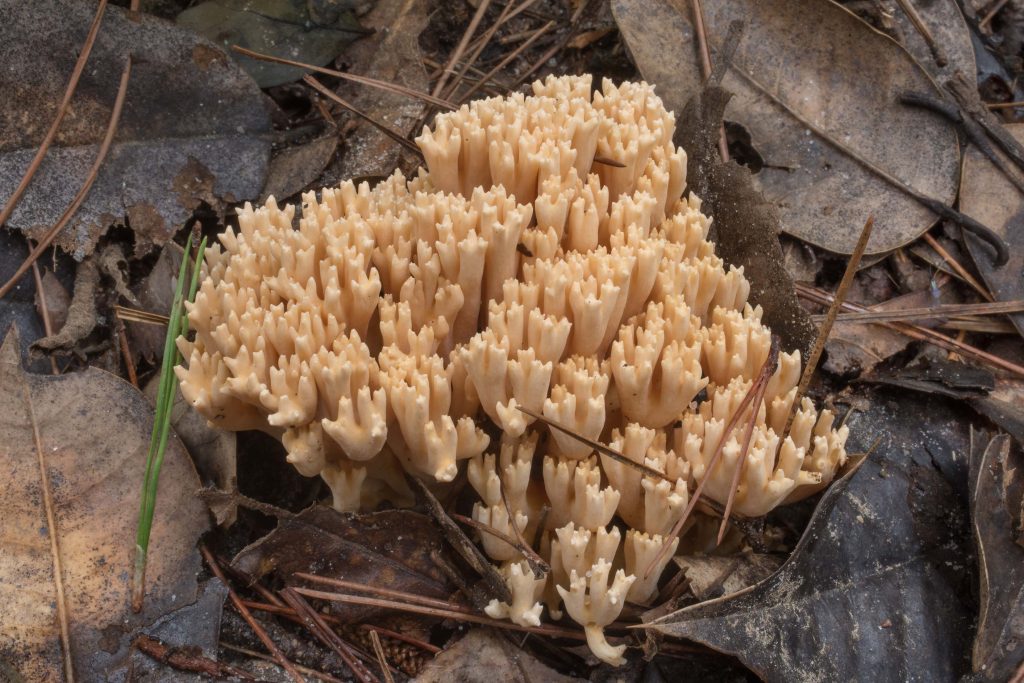Ramaria formosa is justified in being called the “Beautiful Clavaria”. In its early form, this rare, broadleaf woodland fungus has striking coral- or salmon-pink branches, with distinctive and well-contrasting yellow tips. Unfortunately, this truly beautiful young form does not last long, and with maturation, the fruiting body will become a rather boring washed-out orangish tan color. [i]
The name of the genera, Ramaria, comes from the fact that mushrooms in this genus possess numerous branches. Hence, “Ram-“ meaning Ramus or branch , and “-aria” meaning having or being furnished with. As for “formosa”, refers back to the beauty of this specific species, derived from the Latin word “formosus” meaning beautiful. Thus the name of this species means “beautifully branched” or “beautifully formed”.[ii]
In 1797, the German mycologist Christian Hendrik Persoon first described this species under the name Clavaria formosa. It was not until 1888 that this species would come to be known by its currently-accepted scientific name thanks to the French mycologist Lucien Quélet who redescribed it as Ramaria formosa.[iii]
Identification and Description[iv] [v]
Fruiting body: The fruiting body is coral-like, measuring 12 to 20 cm high and broad.
- The Base of the fruiting body: Well developed underneath the main fruiting body. Often several branches emanate from the base, making the fruiting body seem like a collection of smaller corals. The base is often white but becomes a similar salmon-pink color closer to the branches.
- Branches/Stalk: Several stalks emanate vertically from the base. The stalks are thick at the base and branch repeatedly, often with two or three or sometimes more shorter branches. The height of the stalks reaches approximately 6cm tall and wide. The base of the stalk is white, while the color of the branches changes based on age. When young, the branches are pinkish yellow or pinkish-orange, but in age they turn to a washed-out orange to yellowish tan color. The branch tips are a contrasting clear yellow color.
Flesh: The flesh of the fruiting body is soft, solid, and pinkish orange in color. The flesh becomes brittle and chalk-like when dry and bruises pinkish-brown on handling. Furthermore, it is inamyloid meaning that its flesh does not turn a red or blue color when treated with Melzer’s reagent or Lugol’s solution.
Spores: The spores of this species are oblong to stretched-elliptical and have a roughened/warty surface. The size of the spores is variable, they measure 8-15 x 3-6 µm.
Spore print: R. formosa has an orange to yellow spore print.
Smell: No distinctive odor.
Edibility & Taste: Ramaria formosa is poisonous/toxic and is NOT edible. This species is said to have a bitter taste.
Habitat: R. formosa grows single, scattered, or gregarious on the ground in mycorrhizal association with hardwoods and conifers, such as oak, Douglas-fir, and western hemlock.
Fruiting season: This species fruits from July to November.
Range: According to most mycological sources this species can be found widely distributed throughout many North America as well as throughout most of continental Europe, particularly concentrated around the Mediterranean and the Iberian Peninsula.
Look-ALikes[vi]
Ramaria formosa can sometimes be confused with other Ramaria species. Two important features that will help distinguish R. formosa from other species include:
- The flesh of Ramaria formosa bruises brown to pink when handled.
- The flesh of Ramaria formosa is inamyloid.
Further differentiating features for specific species:
- Ramaria stricta possesses more vertical branches which are cream or white.
- Ramaria rubricarnata has smaller spores, measuring 11 by 4.5µm, as well as amyloid flesh.
- Ramaria largentii has bright orange branches and tips, as well as longer spores measuring 13 × 4.5 μm.
- Ramaria aurea does not bruise brown to pink when damaged.
Ramaria Formosa Safety and Toxicity[vii]
If the bitter taste does not deter one from ingesting this species, they would subject themselves to mild to moderate, self-limited gastrointestinal toxicity manifested by variable symptoms such as nausea and/or vomiting, colicky or crampy abdominal pain, and diarrhea.
References:
[i] Davis, R. M., Sommer, R., & Menge, J. A. (2012). Ramaria formosa. In Field Guide to Mushrooms of western North America, University of California Press. (pp. 296–297).
[ii] First Nature. Ramaria formosa (Pers.) Quél.
[iii] First Nature. Ramaria formosa (Pers.) Quél.
[iv] Kuo, M. (2009, May). Ramaria formosa
[v] Lincoff, G. (1981). Ramaria formosa. In National Audubon Society Field Guide to North American mushrooms (pp. 408–409). Knopf.
[vi] Davis, R. M., Sommer, R., & Menge, J. A. (2012). Ramaria formosa. In Field Guide to Mushrooms of western North America, University of California Press. (pp. 296–297).
[vii] North P. (1967). Poisonous Plants and Fungi in Colour. Blandford Press & Pharmacological Society of Great Britain. (pp. 109–110)



